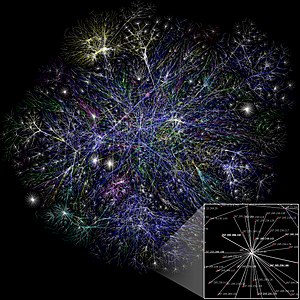
- Image via Wikipedia
Sooner than you think — and the race has lately caused a ‘catfight’
When physicists puzzle out the workings of some new part of nature, that knowledge can be used to build devices that do amazing things — airplanes that fly, radios that reach millions of listeners. When we come to understand how brains function, we should become able to build amazing devices with cognitive abilities — such as cognitive cars that are better at driving than we are because they communicate with other cars and share knowledge on road conditions. In 2008, the National Academy of Engineering chose as one of its grand challenges to reverse-engineer the human brain. When will this happen? Some are predicting that the first wave of results will arrive within the decade, propelled by rapid advances in both brain science and computer science. This sounds astonishing, but it’s becoming increasingly plausible. So plausible, in fact, that the great race to reverse-engineer the brain is already triggering a dispute over historic “firsts.”
The backdrop for the debate is one of dramatic progress. Neuroscientists are disassembling brains into their component parts, down to the last molecule, and trying to understand how they work from the bottom up. Researchers are racing to work out the wiring diagrams of big brains, starting with mice, cats and eventually humans, a new field called connectomics. New techniques are making it possible to record from many neurons simultaneously, and to selectively stimulate or silence specific neurons. There is an excitement in the air and a sense that we are beginning to understand how the brain works at the circuit level. Brain modelers have so far been limited to modeling small networks with only a few thousand neurons, but this is rapidly changing.
Meanwhile, digital computers are increasing exponentially in processing power, memory storage and communications bandwidth. Up until recently, this was accomplished by accelerating the clock speed, which has leaped from kilohertz to gigahertz in my lifetime. But computer clocks have plateaued and now, advances in computing power are coming from increases in the number of processors and improved abilities to distribute a problem across them. The fastest supercomputers have hundreds of thousands of processors, and graphics processing units (GPUs) give desktop personal computers the same speed that supercomputers had ten years ago. If Moore’s Law of exponential growth in computing power does not break down first, at some point computers should become powerful enough, and our knowledge of the brain should be complete enough, to build devices based on the principles of neural computation. Like brains, these devices will be based on probabilistic rather than deterministic logic and will reason inductively rather than deductively. Now, to the dispute, widely known as the “catfight.” Last November, IBM researcher Dharmendra Modha announced at a supercomputing conference that his team had written a program that simulated a cat brain. This news took many by surprise, since he had leapfrogged over the mouse brain and beaten other groups to this milestone. For this work, Modha won the prestigious ACM Gordon Bell prize, which is awarded to recognize outstanding achievement in high-performance computing applications.
However, his audacious claim was challenged by Henry Markram, a neuroscientist at the Ecole Polytechnique Fédérale de Lausanne and the leader of the Blue Brain project, who announced in 2009 that: “It is not impossible to build a human brain and we can do it in 10 years.”. In an open letter to IBM Chief Technical Officer Bernard Meyerson, Markram accused Modha of “mass deception” and called his paper a “hoax” and a “scam.” This has become a cause célèbre in the blogosphere and remains a hot topic among those of us who inhabit the intersection of brain and computer science.
The crux of the dispute is: What does it mean to model the cat brain? Both groups are simulating a large number of model neurons and connections between them. Both models run much, much slower than real time. The neurons in Modha’s model only have a soma — the cell body containing the cell nucleus — and simplified spikes. In contrast, Markram’s model has detailed reconstructions of neurons, with complex systems of branching connections called dendrites and even a full range of gating and communication mechanisms such as ion channels. The synapses and connections between the neurons in Modha’s model are simplified compared to the detailed biophysical synapses in Markram’s model. These two models are at the extremes of simplicity and complex realism.








![Reblog this post [with Zemanta]](http://img.zemanta.com/reblog_b.png?x-id=06d928c0-89d3-4d42-87f5-5911443643d7)

